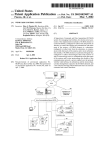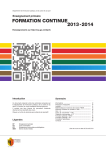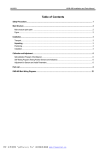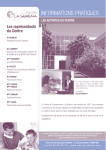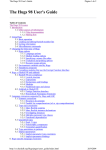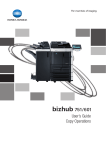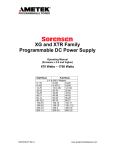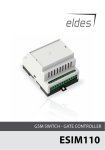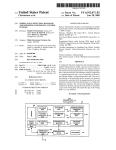Download Apparatus and method for identifying cable phase in a three
Transcript
US006667610B2 (12) United States Patent (10) Patent N0.: (45) Date of Patent: Piesinger (54) APPARATUS AND METHOD FOR IDENTIFYING CABLE PHASE IN A THREE PHASE POWER DISTRIBUTION NETWORK 5,510,700 A 5,521,491 A US 6,667,610 B2 Dec. 23, 2003 4/1996 Pomatto * 6,130,531 A 5/1996 Najam ....................... .. 324/86 10/2000 H210 OTHER PUBLICATIONS (76) Inventor: Gregory Hubert Piesinger, 6225 E. Saguaro Vista Ct., Cave Creek, AZ (US) Satellite Phasing Unit FC4000 User’s manual. ndb Tech 85331 nologie Inc., Feb. 4, 2001. Notice: Subject to any disclaimer, the term of this patent is extended or adjusted under 35 * cited by examiner U.S.C. 154(b) by 0 days. Primary Examiner—John E. Chapman (21) Appl. No.: 10/317,910 Dec. 12, 2002 (22) Filed: Prior Publication Data (65) Assistant Examiner—James C. Kerveros (57) A cable phase identi?cation system and method identi?es US 2003/0169029 A1 Sep. 11, 2003 the phase of a poWer cable at a remote location in a three-phase poWer distribution network. The instantaneous phase at a known phase location is measured and saved each Related US. Application Data (60) Provisional application No. 60/363,076, ?led on Mar. 11, (51) (52) (58) Int. Cl.7 ....................... .. G01R 19/00; G01R 25/00 GPS second using the 1 pps time mark of a GPS receiver. The instantaneous phase at an unknoWn phase location is measured at a single GPS second using the 1 pps time mark of its GPS receiver and compared to the phase measurement taken at the knoWn phase location at the same GPS second. 2002. US. Cl. .......................................... .. 324/66; 324/86 Field of Search .............................. .. 324/66, 76.77, The differential phase betWeen these simultaneously taken 324/76.52, 76.53, 86, 107, 103 R knoWn and unknoWn cable instantaneous phase measure ments Will be close to either 0, +120, or —120 degrees, thus References Cited (56) ABSTRACT identifying the cable phase at the unknoWn phase location. U.S. PATENT DOCUMENTS 4,626,622 A 12/1986 Bouvrette 23 Claims, 5 Drawing Sheets 315 \ N 320 305 335 V 370 // USER CONTROLS 375 / NON-VOLATILE \g MEMORY 345 350 ~ l / V0 PORT V GPS N 360 l CRYSTAL OSCILLATOR 330 / / 355 340 310 390 l I NO _+ PROCESSOR <— 325 300 / \ DISPLAY \ BATTERY \ \ \ 365 380 385 / COMPUTER U.S. Patent Dec. 23, 2003 Sheet 1 0f 5 US 6,667,610 B2 A 55 mm26 m_\ B we nH wkWwA|‘I._.M 5%F k 2 \ ON L k\ 853 mF k vA on P < m \SEP0ommm GE F U.S. Patent Dec. 23, 2003 Sheet 2 0f 5 US 6,667,610 B2 U.S. Patent Dec. 23, 2003 Sheet 3 0f 5 2T, 6E<m22 US 6,667,610 B2 cum mwm mNN CNNm8m3.05www \ 8N 0mm mmw T> 0mm U.S. Patent Dec. 23, 2003 Sheet 4 0f 5 US 6,667,610 B2 U.S. Patent Dec. 23, 2003 Sheet 5 0f 5 US 6,667,610 B2 US 6,667,610 B2 1 2 APPARATUS AND METHOD FOR IDENTIFYING CABLE PHASE IN A THREE PHASE POWER DISTRIBUTION NETWORK on the cable in Which it is knoWn, to another point on the cable in Which it is unknoWn. Pomatto, US. Pat. No. 5,510,700, proposes essentially the same thing only using radio signals. HoWever, both these techniques require cali bration procedures and special training to be used effec RELATED INVENTION tively. The present invention claims priority under 35 U.S.C. §119(e) to: “Apparatus and Method for Identifying Cable Accordingly, it is the object of the present invention to provide a neW and improved method, of identifying the Phase in a 3-Phase PoWer Distribution Network,” Provi sional US. Patent Application Ser. No. 60/363,076, ?led Mar. 11, 2002, Which is incorporated by reference herein. phase of a cable that is easy to use and does not require any 10 calibration procedures or special training on the part of the user. TECHNICAL FIELD OF THE INVENTION The present invention relates to the ?eld of three-phase poWer distribution netWorks. More speci?cally, the present invention relates to the ?eld of identifying the phase of a cable in a three-phase poWer distribution netWork. SUMMARY OF THE INVENTION 15 Brie?y, to achieve the desired object of the present invention, Global Positioning System (GPS) receivers are used at both the knoWn and unknoWn phase locations in the poWer distribution netWork to time-correlate phase information, thereby identifying the phase of the cable in BACKGROUND OF THE INVENTION question. electric utilities to deliver electricity from generating plants Speci?cally, using the 1 pps (one pulse per second) GPS signal, phase information for the knoWn phase Will be to customers. Although the actual distribution voltages Will vary from utility to utility, in a typical netWork, three-phase AWorker at the unknoWn phase location Will simultaneously Electric poWer distribution netWorks are used by the poWer at high voltage (345,000 volts phase-to-phase) is delivered to multiple transmission substations at Which transformers step this high voltage doWn to a loWer three recorded at each GPS second and entered into a computer. also record the cable phase information at a particular 1 pps 25 GPS second on a phase identi?cation meter that Will convert the recorded time and phase to a short alpha or numeric sequence. The Worker Will then give that sequence to the phase voltage (69,000 volts phase-to-phase). This 69,000 volt three-phase poWer then feeds multiple distribution dispatcher. The dispatcher Will determine the phase by substations Whose transformers further step doWn the volt entering the sequence received from the Worker into the age to the distribution voltage (12,470 volts phase-to-phase) computer. The dispatcher Will then relay the cable phase and separate the poWer into three single-phase feeder cables. Typically, these feeder cables operate at 7,200 volts phase designation back to the Worker. In this Way, the Worker determines the cable phase by to-ground. Each of these feeder cables branch into multiple taking a simple meter measurement in much the same Way voltage and current measurements are taken. Therefore, no circuits to poWer a plurality of local pole-mounted or pad-mounted transformers Which step the voltage doWn to a ?nal voltage of 120 and 240 volts for delivery to the 35 special procedures or training is required on the part of the Worker. commercial and residential customers. BRIEF DESCRIPTION OF THE DRAWINGS Ideally, the utilities try to initially design the feeder FIG. 1 is an illustration of a typical poWer distribution netWork. circuits such that the current loads on each single-phase output of the three-phase transformer are equal. HoWever, over time as neW customers are added, one of the phases may become more heavily loaded than the others. To re-balance the loading, some of the branch circuits are moved from the more heavily loaded phase to the more lightly loaded phases. 45 FIG. 2 illustrates voltage phase relationships in a three phase poWer netWork. FIG. 2A illustrates the phase relation ships as a phasor diagram. FIG. 2B illustrates the phase relationships as a voltage-time diagram. FIG. 3 illustrates the equivalent circuit of a transformer To re-balance the loading, the phase of each cable in a distribution cabinet must be accurately knoWn. OtherWise, a cable may be erroneously removed from a more lightly loaded phase and placed on the more heavily loaded phase. and the phase shift through it. FIG. 3A illustrates the equivalent circuit of a transformer referred to the secondary. FIG. 3B illustrates a phasor diagram associated With the equivalent circuit. If this happens, the procedure Will have to be repeated again, FIG. 4 illustrates a conceptual block diagram of a phase Which Will cause a second disruption in service to all customers on the branch being re-phased. In the Worst case, identi?cation meter. FIG. 5 illustrates secondary voltage phase relationships in adding a greater load to the more heavily loaded phase may cause the substation fuse to bloW on that phase, resulting in a three-phase poWer netWork. FIG. 5A illustrates a Wye 55 connected transformer and FIG. 5B illustrates a delta a large poWer outage for all customers on the more heavily connected transformer. FIG. 5C is a vector diagram of the loaded phase. Currently, to accurately identify the phase of a particular feeder branch, utility company personnel must physically secondary output voltage phases in Wye-connected and delta-connected transformers. DETAILED DESCRIPTION OF THE PREFERRED EMBODIMENTS trace a cable run back through various distribution cabinets until they reach a point in the distribution netWork at Which the phase is de?nitely knoWn. This can be a very time The goal of the present invention is to provide the utility consuming process. Worker With an easy to use phase identi?cation apparatus and method for identifying the phase of a cable in a Various devices and methods have been described to assist in the phase identi?cation of cables. Bouvrette, US. Pat. No. 4,626,622, proposes using modems and telephone lines to transmit a signal associated With the phase, at a point 65 three-phase poWer distribution netWork. FIG. 1 illustrates a typical poWer distribution netWork in Which three-phase poWer cables 5 at 345 kilovolts feed a US 6,667,610 B2 3 4 series of transmission substation (TS) transformers 10 embodiment, the predetermined voltage is Zero volts and the spread out over a large geographical area. The 69-kilovolt outputs 15 of TS transformers 10 are connected to a series of distribution substation (DS) transformers 20 situated over a smaller geographical area. The 7.2-kilovolt phase-to predetermined direction is rising, i.e., from negative to positive. That is, all voltages Would rise though Zero volts at substantially the same time. In the present invention, the phase of the voltage Wave forms at tWo Widely separated points in the poWer distribu tion netWork are observed and compared at substantially the ground (12.5-kilovolt phase-to-phase) phase-A feeder out put 25 of a DS transformer 20 poWers a local distribution network, Which contains a number of pole-mounted or same instant (i.e., the instantaneous phase) using time sig nals from the Global Positioning System (GPS). The GPS pad-mounted (PM) transformers 40 that are used to provide the ?nal 120/240-volt poWer to the commercial or residential customers. In the same manner, phase-B feeder output 30 of alloWs all users to have precision time correlation so that a voltage sample can be taken at different locations at sub stantially the same time. The time marks in FIG. 2B illus trate the method by Which the unknoWn phase on the cable transformer 20 poWers another local distribution netWork, While phase-C feeder output 35 poWers a third local net Work. under test can be determined. At some location in the poWer distribution netWork, a PM 15 transformer 50 is used to provide a loW-voltage input reference of phase A, B, or C to a permanently attached reference phase identi?cation meter 55 (hereinafter refer ence meter 55). This reference meter 55 most likely Will be situated in the dispatch facility. The purpose of the reference meter 55 is to provide a reference of phase A, B, or C that can be used to determine the unknoWn phase of a cable at any other location in the netWork. A Worker at a remote location uses another phase identi?cation meter 65 (hereinafter test meter 65) to momentarily probe the voltage Those skilled in the art Will appreciate that the phrase “instantaneous phase” is taken to mean the phase of each sample synchroniZed to substantially the same instant. The absolute time require to take each sample is irrelevant to this discussion. It Will also be appreciated that a determination of phase may be performed in any of numerous Ways Well knoWn to those skilled in the art, including, but not limited to, the time duration methodology discussed herein. In FIG. 2B, assume that at some instant of GPS time a 25 on the cable Whose phase is to be determined. timer is started at time t0 130. At the reference phase site (assumed here to be connected to phase A), the timer is stopped When phase Avoltage rises through Zero volts. This FIG. 2A illustrates the phase relationship betWeen phases represents a time interval ta 140 since time t0. Since the time A, B, and C in a three-phase poWer distribution netWork. difference betWeen phases is 5.55 milliseconds, time interval Phasor diagram 95 represents phase A as vector 100 at Zero tb 145 of phase B and time interval tc 135 of phase C can be calculated directly Without having to actually measure the voltage on phases B and C. At the point of unknoWn phase, a similar timer is also degrees, phase B as vector 105 at 120 degrees, and phase C as vector 110 at 240 degrees. In a 60 HZ poWer netWork, the entire phase diagram rotates at a rate of 60 revolutions per second but the phase difference betWeen phases A, B, and C started at time t0 130 as determined by GPS time. The timer remains constant. Each revolution of the phase diagram represents 360 degrees of phase rotation by the voltage 35 This represents a time interval tX. The time interval tX Will be very close to one of the time intervals ta, tb, or tc, vectors. Because phase is rotational, each phase may be said to both lead and lag each other phase. That is, depending upon the point of references, phase A leads phase B and phase B lags phase A. For the complete diagram: phase Aleads phase B, phase B leads phase C, and phase C leads phase Aby 120 degrees; phase Aleads phase C, phase B leads phase A, and phase C leads phase B by 240 degrees; phase A lags phase C, phase B lags phase A, and phase C lags phase B by 120 degrees; and phase A lags phase B, phase B lags phase C, and phase C lags phase A by 240 degrees. is stopped When the cable voltage rises through Zero volts. depending on Whether the cable is phase A, B, or C, respectively. Therefore, the unknoWn phase of the cable under test may be determined simply by comparing the time interval of the test meter 65 to that of the reference meter 55. This method is vastly superior to the prior art mentioned 45 FIG. 2B illustrates the same phase relationship in a voltage Waveform versus time diagram 100. To complete a earlier because transmission of a real-time reference signal from the reference site to the remote site is not required. Since the GPS alloWs the measurements to be taken and recorded at both locations at substantially the same time, the required reference information can be obtained and recorded by the reference meter and retrieved at any convenient time and in any convenient manner. A Worker could gather single 360-degree cycle of phase rotation, the voltage of information at multiple remote sites so as to later determine each phase starts at Zero volts, peaks in the positive direction, returns to Zero volts, peaks in the negative direction, and again returns to Zero volts. Phase A, B, and C the phase of a number of cables. This information may be obtained and recorded in the ?eld, then compared With are represented by voltage Waveforms 115, 120, and 125 respectively. 55 the Worker for each cable, the unknoWn phases could be For poWer at 60 HZ, each cycle takes 16.67 milliseconds to complete a 360-degree cycle. This is equivalent to 46.3 microseconds per degree or 5 .55 milliseconds for 120 determined. For in-?eld determination of the cable phase, the Worker degrees. Therefore, phases A, B, and C are separated in time by 5.55 milliseconds. could call the dispatcher and relay the information obtained Since the frequency of 60 HZ poWer distribution netWorks is so loW, there is very little voltage phase shift betWeen tWo points on the same phase anyWhere in the netWork. That is, if one Were to observe the voltage Waveforms of phase A at Widely separated points in the netWork, all voltages Would stored reference information upon return to the shop. As long as the reference meter recorded reference information at times that matched at least one of the times recorded by 65 by the test meter. This information Would contain the start time t0 and the time interval tX for the test cable. The dispatcher Would enter this information into the reference meter, a computer, or other instrument. The information Would be compared to the stored reference information for the same start time t0, and the unknoWn phase determined. pass through a predetermined voltage in a predetermined The dispatcher Would then relay this phase information to direction at substantially the same time. In the preferred the Worker. US 6,667,610 B2 5 6 GPS receivers typically output a time mark at 1-second intervals. These time marks are locked to GPS time in seconds. This provides convenient time frames for the reference meter to take and record reference phase informa tion. The test meter used by the Worker Would also collect data at the same 1-second time mark as determined by its GPS receiver. The dispatcher’s computer or other instrument The total voltage phase-error budget is plus or minus 59 degrees. The phase uncertainties due to propagation and GPS time tagging are less than plus or minus 10 degrees as Was explained earlier. Therefore, nearly plus or minus 50 degrees of transformer phase shift can be tolerated before the accuracy of identifying the unknoWn phase is compro mised. This large alloWable phase uncertainty alloWs the Would search back through the recorded reference-meter reference meter and test meter to be separated by many transformers. That is, phase A in the netWork is essentially data to ?nd the data collected at the same GPS second as the test meter to determine the unknoWn phase. 10 the same everyWhere in the netWork, so the reference meter degrees, it is not necessary to measure phase precisely to can be placed almost anyWhere, including on the dispatch er’s desk and plugged into his Wall socket. The Wall socket identify the unknoWn phase. If the unknoWn phase is Within does not even have to be phase A. As long as the reference Note that since phases A, B, and C are separated by 120 plus or minus 59 degrees of one of the reference phases, the unknoWn phase Will be accurately determined. If 60 HZ meter knoWs Which phase the reference phase is, the phase 15 A descriptive block diagram of the Worker’s phase iden poWer propagated through the cable at the speed of light (the actual propagation velocity is slightly less), it Would require ti?cation meter (the test meter) is illustrated in FIG. 4. The approximately 8.6 miles of cable to obtain 1 degree of phase shift. Therefore, based upon propagation phase shifts, a service radius around the reference meter of up to 120 miles identi?cation method that Was described here Will Work. test meter 300 may be attached to the end of a hot stick and the meter’s voltage probe 320 placed against a poWer line 20 315. The poWer line is modeled as an AC voltage With respect to ground by voltage source 305 and ground 310. The test meter is connected to ground through grounding is attainable. Assuming a 10-degree error budget for propa gation velocity, the service radius is at least 80 miles. A time uncertainty of 100 nanoseconds represents approximately 0.002 degrees of phase shift at 60 HZ. GPS Wire 340. A voltage reducer betWeen the poWer line and ground is receivers determine time much more accurate than 100 25 used. The voltage reducer may be formed of a voltage nanoseconds so GPS time uncertainty is simply not an issue divider having a high value (on the order of 10 million in this application. Another potential source of voltage phase shift in the netWork (other than from poWer factor correction circuits) is the voltage phase shift that can occur in trans formers. FIG. 3 illustrates their potential phase shift. FIG. 3A represents the equivalent circuit 200 of a trans ohms) poWer line resistor 335 in series With a loW value (on the order of 1000 ohms) probe resistor 325. The high-value resistor 335 connects to the poWer line and the loW-value 30 former. In this representation, the primary voltage Vp at the input terminal 210 produces secondary voltage Vs at the output terminal 225. A loss-free transformer 205 reduces the primary voltage Vp by the factor “a” based on the primary 35 to secondary turns ratio. All transformer losses, referred to the secondary here, further reduce voltage Vs and cause its ing through resister 215. The voltage drop due to trans former reactance Xe is represented by current passing through inductor 220. The heart of test meter 300 is processor 350. The proces computing resources. A/D converter 345 converts poWer 40 In FIG. 3B, the greatly exaggerated phasor diagram 250 illustrates hoW phase shift through a transformer occurs. When a lagging poWer factor load 230 is placed on the 45 output of the transformer, secondary current Is, represented by vector 260, ?oWs out of phase With the secondary voltage Vs, represented by vector 255 as is Well knoWn by those skilled in the art. The poWer factor phase shift 275 is determined by the poWer factor of the load 230. The voltage drop due to Re is in phase With secondary current Is and is represented by vector 265. The voltage drop due to Xe is 90 degrees out of phase With secondary current Is and is represented by vector 270. The vector addition of positive transition of the poWer line voltage, as measured by A/D converter 345, commands the processor to stop the interval timer and record the time interval along With the GPS time that initiated the timer. A measurement algorithm Will be programmed into the recorded and displayed. For example, after the operator 50 presses a “take measurement button,” the test meter may Wait until the amplitude of the poWer-line voltage across probe resistor 325 reaches a predetermined value. It Will then take measurements at more than one GPS second and 55 con?rm that successive measurements produce similar timer counts (time intervals) based on the frequency of the poWer line voltage. At 60 HZ, exactly 60 cycles occur each GPS second so that all timer intervals should be identical. HoWever, in a typical poWer distribution netWork, the poWer line frequency may randomly vary from exactly 60 HZ by a Since no phase shift occurs through loss-free transformer 205, transformer phase shift 280 represents the voltage 60 modern poWer distribution transformers, poWer losses are only a feW percent so the resistive and reactive voltage drops are very small compared to their primary and secondary line voltage into a digital signal. The 1 pps GPS signal is received by a GPS receiver 360 and commands the proces sor 350 to start its internal interval timer. The negative to processor to ensure that only good measurement data is these voltage drops to secondary voltage Vs equals the loss-free turns ratio voltage Vp/a represented by vector 275. phase shift due to the transformer. The phase shift through a transformer depends on the magnitude and poWer factor of the load current. HoWever, in digital converter 345, only a feW millivolts of poWer line voltage needs to be developed across probe resistor 325. Back to back voltage-clamping diodes 330 protect A/D converter 345 from damage due to any over voltages. sor contains an internal interval timer, a memory, and phase to be shifted With respect to Vp. The voltage drop due to transformer resistance Re is represented by current pass resistor 325 connects to ground to step doWn the high voltage poWer-line voltage. Using a sensitive analog to small amount (usually a feW tenths of a percent or less). As long as successive timer intervals are Within the assumed tolerance, a measurement Will be recorded and displayed, along With an indication to the Worker that the measurement is completed. 65 To guard against loss of the 1 pps GPS signal, a crystal voltages. Therefore, voltage phase shift through the trans oscillator 355 Will be locked to GPS time. This alloWs the former is typically less than plus or minus 5 degrees. test meter to be used inside cabinets or in other areas Which US 6,667,610 B2 7 8 block reception of the GPS signal. Typical crystal oscillators computer Would handle all measurement storage and phase have a short-term accuracy on the order of 1 part per million identi?cation functions. (ppm). Since the phase of a 60 HZ poWer line voltage rotates 1 degree per 46.3 microseconds, it takes 46.3 seconds for a clock that is in error by 1 ppm to accumulate 1 degree of phase uncertainty. For a 10-degree error budget, the GPS receiver could lose lock for 7.7 minutes. Therefore, once GPS lock is obtained in a clear area, the test meter can be moved to a shielded area to obtain the phase measurement. Other resources contained in the test meter 300 are In a large metropolitan area, multiple reference phase instruments might be used at various locations for redun dancy and reliability cross checking. Also, if it is found that a signi?cant phase shift occurs in certain branches due to poWer-factor correction circuits or other causes, that infor mation can be entered into the reference meter database. To take those phase shifts into account, the dispatcher Would 10 the unknoWn phase measurement along With the unknoWn phase sequence. The computer Would then remove the display 365, user controls 370, non-volatile memory 375, battery 380, and input-output port 385. The crystal oscillator 355 provides the processor With an accurate clock frequency so as to maintain the 1 pps timing during periods of GPS signal outages. Display 365 Will be a typical LCD meter display to display the phase information to the Worker. User controls 370 include the on-off sWitch and any other buttons required to activate various features built into the test meter. Battery 380 alloWs the test meter to operate on battery poWer. Non-volatile memory 375 alloWs measurement data to be retained after the test meter is turned off. Input-output port 385 alloWs measurement information to be doWnloaded knoWn phase offset in making the determination of the unknoWn phase. 15 Relative phase measurements taken on the phase A, B, or C primary voltages Will alWays be close to one of three reference phase angles Which are separated by 120 degrees. HoWever, relative phase measurements taken on secondary voltages can be separated by only 30 degrees as is illustrated in FIG. 5. Vector diagram 400 represents the 12 different secondary phases that can be obtained on Wye and delta connected transformers. to a computer 390. It is anticipated that a mode Will be offered in Which GPS time is designated in terms of the number of seconds since the last GPS hour. That is, the number Would range from 1 second to 3600 seconds. Also, the interval timer count could have to enter information identifying the branch circuit of The most common transformer connection in distribution 25 netWorks is the four-Wire Wye arrangement in Which three phase poWer is transported using a Wire for each of the three phases plus a fourth grounded neutral Wire. In a Wye arrangement, the primary side of each single-phase PM be quanti?ed to increments of 1 degree. That is, the time transformer is connected across one of the three primary duration betWeen a GPS second and the ?rst poWer line phases and neutral. A grounded center tap secondary Wind voltage negative to positive Zero crossing Would range betWeen 1 and 360 degrees. To make the phase identi?cation sequence (the gathered ing supplies the commercial or residential customer 120 and 240 volts in Which one of the 120-volt circuits is in phase With the primary Winding phase and the other 120-volt circuit is 180 degrees out of phase With the primary Winding phase information) as short as possible, a single sequence could be used in Which a number betWeen 1 and 360 represents the time duration collected during the ?rst GPS second. A number betWeen 361 and 720 represents the time 35 phase. duration collected during the second GPS second and so on. FIG. 5A illustrates the Wye-connected transformer in Which the primary Winding 405 is connected to phase A and the secondary Winding output 410 is in phase With the The largest possible number Would be equal to 3600 times primary Winding voltage and the secondary Winding output 360. This number in turn could be converted to letters in 415 is out of phase With the primary Winding voltage. In Which “A” represents “1”, “B” represents “2”, “Z” repre FIG. 5C, the primary phase angle is represented by vector 435 While the in phase secondary output 410 is represented sents “26”, “AA” represents “27”, and so on. In this Way, the largest number could be represented using only ?ve letters. Reducing the phase identi?cation sequence to only ?ve letters minimiZes the time it takes the Worker to verbally communicate the sequence to the dispatcher and minimiZes the time it takes the dispatcher to enter the sequence into the 45 ers on phase A, the measured phase Will be either 0 or 180 degrees. In a similar manner, secondary voltages derived from Wye-connected transformers on phase B Will indicate a phase angle of either 120 or 300 degrees While Wye reference meter or computer. It also increases accuracy in that the phonetic alphabet can be used With letters. For eXample, the sequence “MHE” Would be communicated as connected transformers on phase C Will indicate a phase angle of either 240 or 60 degrees. Three-phase poWer can also be distributed in a three-Wire delta arrangement in Which a Wire is used for each of the “mike, hotel, echo.” The permanently attached reference meter Will operate in essentially the same manner as the test meter. One difference is in the voltage probe 320. The reference meter Will likely be “hard Wired” to the reference phase voltage, most likely through a normal 120-volt Wall socket. Most likely, the voltage reducer Will be a simple Wall socket step-doWn transformer coupled betWeen the poWer line and neutral by vector 440 and the out of phase output 415 by vector 445. Therefore, When the phase identi?cation meter is applied to secondary voltages derived from Wye connected transform three phases. The primary side of each single-phase PM 55 transformer is then connected across tWo of the three pri mary phases. A grounded center tap secondary Winding supplies the commercial or residential customer 120 and 240 volts in Which one of the 120 volt circuits is in phase With (ground), instead of the resistor divider circuit (335 and 325) the primary Winding phase and the other 120 volt circuit is used in the test meter 300. The reference meter may also have more computing 180 degrees out of phase With the primary Winding phase. poWer and a larger memory for storing phase measurements. It may also contain a keyboard to enter the phase identi? the primary Winding 420 is connected across primary phases A and B. The secondary Winding output 425 is in phase With FIG. 5B illustrates a delta-connected transformer in Which the primary Winding phase and secondary Winding output cation sequence obtained from the Worker at the unknoWn phase location. Conversely, the reference meter may simply 65 430 is out of phase With the primary Winding phase. In FIG. transfer all measurement data to one or more computers in 5C, the primary Winding phase angle is represented by real time. If so, a softWare program running on the host vector 450 Which is a vector from the voltage on the primary US 6,667,610 B2 9 10 Winding terminal connected to phase A to the voltage on the identi?cation sequence or it could automatically receive and primary Winding terminal connected to phase B. The in phase secondary output 425 is represented by vector 455 and the out of phase output 430 by vector 460. Therefore, When the phase identi?cation meter is applied to secondary volt store all neW sequences as they became available. A collec tion of the most current (last minute) reference sequences could be continuously broadcast to a receiver Within the test meter and the unknoWn cable phase determined automati cally using the test meter. The broadcast could be via PM ages derived from a delta-connected transformer connected across phases Aand B, the measured phase Will be either 150 or 330 degrees. In a similar manner, secondary voltages subcarrier on a local FM station or satellite. Also, the described apparatus and method Will Work equally Well at other poWer-line frequencies and in other derived from a delta connected transformer across phases B and C Will indicate a phase angle of either 270 or 90 degrees 10 While a delta connected transformer across phases C and A Will indicate a phase angle of either 30 or 210 degrees. Using the phase identi?cation meter on secondary volt ages reduces the total phase error budget from plus and polyphase netWorks such as 50 HZ netWorks or 2-phase netWorks. What is claimed is: 1. An apparatus for identifying a cable phase in a three phase poWer distribution netWork, Wherein: said three-phase poWer distribution netWork comprises: minus 59 degrees to plus and minus 14 degrees. HoWever, phase measurement tests made at Widely separated points on a ?rst phase; an actual poWer distribution netWork indicate that actual phase errors are much less than 14 degrees (they Were a second phase lagging said ?rst phase by 120 degrees; actually less than 5 degrees). Identifying cable phase by measuring secondary voltages is preferable by utilities to measuring primary voltages because it can be performed by a third phase lagging said ?rst phase by 240 degrees; and and said apparatus comprises: personnel that are not high-voltage certi?ed. An accessory attachment may be supplied With the phase identi?cation meter to alloW it to be simply plugged into any commercial or residential Wall socket to determine Which primary phase 25 poWers the facility. Although the preferred embodiments of the invention a second phase identi?cation meter coupled to a second cable at a second location in said netWork and of user features. For example, to speed up measurements on a series of cally stored in the test meter. Each neW measurement Would be initiated upon detection of neW poWer line voltage that occurs a feW seconds after the previous poWer line voltage terminates. This feature Would alloW the Worker to measure predetermined Global Positioning System (GPS) time, Wherein said phase data relative to said ?rst cable comprises a ?rst interval; have been illustrated and described in detail, it Will be readily apparent to those skilled in the art that various modi?cations may be made therein Without departing from the spirit of the invention. This is especially true in the area overhead lines, multiple measurements may be automati a ?rst phase identi?cation meter coupled to a ?rst cable at a ?rst location in said netWork and con?gured to gather phase data relative to said ?rst cable at a 35 con?gured to gather phase data relative to said second cable at said predetermined GPS time, said phase data relative to said second cable comprises a second interval; and a computer con?gured to receive said phase data from each of said ?rst and second phase identi?cation meters and to identify said cable phase in response to said data, Wherein: a difference of said ?rst and second intervals corre the phase on a number of high overhead lines Without having sponds to an angular displacement; and said phase of said ?rst cable lags said ?rst phase by 0 degrees. to retrieve the test meter after each measurement. It is also possible to capacitively couple the test meter probe to the poWer line, instead of actually touching bare 2. An apparatus as claimed in claim 1 Wherein said ?rst Wire, if the actual or estimated phase shift is accounted for. This feature Would alloW the test meter to be used on 45 phase identi?cation meter comprises: a processor con?gured to gather said phase data; insulated cables. To limit maXimum propagation phase error, the test and a GPS receiver coupled to said processor and con?gured to cause said processor to start gathering said phase reference meters could be programmed to only operate data; and an analog to digital (A/D) converter coupled betWeen said inside a designated service area. Location coordinates from the GPS receiver could be compared to a map programmed ?rst cable and said processor, and con?gured to cause into the processor of each meter to determine if the meter said processor to stop gathering said phase data. Was inside the service area. 3. An apparatus as claimed in claim 2 Wherein: said CPS receiver is con?gured to cause said processor to start gathering said phase data at a start time, said start Many different Ways of communicating the test meter phase identi?cation sequence (the gathered phase information) to the reference meter or computer are possible. The sequence could be called in using a utility radio, a cell phone, or a landline phone. A modem or computer could be used to send or E-mail the sequence. The sequence could be 55 simply Written doWn and delivered by courier, mail, or personally by the Worker. time being said predetermined GPS time; said A/D converter is con?gured to cause said processor to stop gathering said phase data at a stop time, said stop time being When a voltage on said ?rst cable crosses Zero in a predetermined direction; and Alternatively, one or more reference meter phase identi ?cation sequences could be delivered to the test location and said phase data comprises: the unknoWn cable phase determined using either the test a time interval betWeen said start time and said stop time. 4. An apparatus as claimed in claim 1 Wherein: a ?rst one of said ?rst and second phase identi?cation meter or a computer. Again, many different Ways of com municating the reference meter sequences to the test meter 65 or computer are possible. The test location computer could query the reference location computer for the required phase said start time; and meters is a reference meter; US 6,667,610 B2 11 12 a second one of said ?rst and second phase identi?cation 12. An apparatus as claimed in claim 1 Wherein: said second location is on a secondary of a single-phase transformer coupled to one leg of a delta-connected meters is a test meter; said reference meter is coupled to one of said ?rst and transformer; second cables having a knoWn phase; said test meter is coupled to one of said ?rst and second 5 cables having an unknown phase, said cable being the cable Whose phase is to be identi?ed by said apparatus; phases When said angular displacement is one of 150 degrees and 330 degrees; said one leg is coupled betWeen said second and third phases When said angular displacement is one of 270 and said computer is con?gured to identify said cable phase by comparing said phase data for said unknoWn phase to said phase data for said reference phase. said one leg is coupled betWeen said ?rst and second 10 degrees and 90 degrees; and said one leg is coupled betWeen said third and ?rst phases When said angular displacement is one of 30 degrees and 210 degrees. 13. An apparatus for identifying a cable phase in a three-phase poWer distribution netWork Wherein: said three-phase poWer distribution netWork comprises: 5. An apparatus as claimed in claim 1 Wherein said ?rst location is Within 120 miles of said second location. 6. An apparatus as claimed in claim 5 Wherein: an error budget of 10 degrees is used; and said ?rst location is Within 80 miles of said second location. 7. An apparatus as claimed in claim 1 Wherein said ?rst a ?rst phase; a second phase lagging said ?rst phase by 120 degrees; and phase identi?cation meter comprises: a third phase lagging said second phase by 120 degrees; and an analog to digital (A/D) converter coupled to said ?rst said apparatus comprises: cable; a processor coupled to and con?gured to control said A/D converter; 25 a timer coupled to said processor and con?gured to control and to be controlled by said A/D converter a ?rst phase identi?cation meter coupled to a ?rst cable at a ?rst location in said netWork and con?gured to gather phase data relative to said ?rst cable at a predetermined Global Positioning System (GPS) time, Wherein said phase data relative to said ?rst cable comprises a ?rst time interval; through said processor; and a GPS receiver coupled to said processor and con?gured to control said timer through said processor. 8. An apparatus as claimed in claim 7 Wherein said OPS receiver is con?gured to synchroniZe said timer to a OPS said apparatus additionally comprises a second phase identi?cation meter coupled to a second cable at a second location in said netWork and con?gured to gather phase data relative to said second cable at said time signal. 9. An apparatus as claimed in claim 8 Wherein: said GPS receiver is con?gured to establish a start time for said A/D converter When said GPS receiver is receiving predetermined GPS time, Wherein said phase data said GPS time signal; and said ?rst phase identi?cation meter additionally com prises a crystal oscillator con?gured to track said GPS time signal and establish said start time When said GPS receiver is not receiving said GPS time signal. 10. An apparatus as claimed in claim 1 Wherein said ?rst phase identi?cation meter comprises: a processor con?gured to generate a timing event; a GPS receiver coupled to said processor and con?gured to establish a start time for said timing event, said start relative to said second cable comprises a second time 35 45 interval; and a computer con?gured to receive said phase data from each of said ?rst and second phase identi?cation meters and to identify said cable phase in response to said data Wherein: said ?rst cable is at said ?rst phase; said second cable is at said ?rst phase When said second time interval is substantially equal to said ?rst time interval; said second cable is at said second phase When said second interval is one of longer than said ?rst interval by substantially 120 degrees and shorter than said ?rst interval by substantially 240 degrees; and time being said predetermined OPS time; and an A/D converter coupled to said ?rst cable and to said said second cable is at said third phase When said second interval is one of longer than said ?rst processor, said A/D converter being con?gured to sample a voltage on said ?rst cable during said timing interval by substantially 240 degrees and shorter than said ?rst interval by substantially 120 event and to terminate said timing event When said voltage crosses Zero in a predetermined direction. 11. An apparatus as claimed in claim 1 Wherein: said second location is on a secondary of a single-phase transformer coupled to one leg of a Wye-connected degrees. 14. A method for identifying a phase of a cable in a three-phase poWer distribution netWork, said method com prising: transformer; connecting a ?rst phase identi?cation meter to a ?rst cable at a ?rst point in said poWer distribution netWork; connecting a second phase identi?cation meter to a sec ond cable at a second point in said poWer distribution a phase of said one leg is said ?rst phase When said angular displacement is one of 0 degrees and 180 degrees; a phase of said one leg is said second phase When said angular displacement is one of 120 degrees and 300 netWork; synchroniZing said ?rst and second phase identi?cation degrees; and a phase of said one leg is said third phase When said angular displacement is one of 240 degrees and 60 degrees. meters so a start time is substantially identical for each 65 of said ?rst and second phase identi?cation meters; measuring, With said ?rst phase identi?cation meter, a ?rst interval betWeen said start time and a ?rst stop time US 6,667,610 B2 14 13 measuring, With said second phase identi?cation meter, a When a voltage on said ?rst cable passes through a predetermined voltage in a predetermined direction; second interval betWeen said start time and a second stop time When a voltage on said second cable passes measuring, With said second phase identi?cation meter, a through said predetermined voltage in said predeter second interval betWeen said start time and a second stop time When a voltage on said second cable passes mined direction; and computing said phase of said second cable in response to said ?rst and second intervals. through said predetermined voltage in said predeter mined direction; and computing said phase of said second cable in response to said ?rst and second intervals, Wherein said computing activity comprises: 19. A method as claimed in claim 18 Wherein said 10 establishing as an unknoWn phase that phase of said three-phase poWer distribution netWork present on receiver; commencing a timing event at said start time; 15 said ?rst cable; establishing as a trailing phase that phase of said three-phase poWer distribution netWork that lags said reference phase by 120 degrees; and establishing said ?rst interval as a duration of said timing event. said reference phase by 120 degrees; ?rst interval by substantially 240 degrees; determining said unknoWn phase to be said leading phase When said second interval is longer than said ?rst interval by substantially 240 degrees; and determining said unknoWn phase to be said leading monitoring said voltage of said cable during said timing event; determining When said voltage passes through said pre determined voltage in said predetermined direction; establishing as a leading phase that phase of said three-phase poWer distribution netWork that leads determining said unknoWn phase to be said reference phase When said second interval is substantially equal to said ?rst interval; determining said unknoWn phase to be said trailing phase When said second interval is longer than said ?rst to interval by substantially 120 degrees; determining said unknoWn phase to be said trailing phase When said second interval is shorter than said comprises: determining said start time in response to a time-signal said second cable; establishing as a reference phase that phase of said three-phase poWer distribution netWork present on measuring activity With said ?rst phase identi?cation meter 20. A method as claimed in claim 18 Wherein said measuring activity With said ?rst phase identi?cation meter 25 additionally comprises: encoding said start time and said ?rst interval as interval data; and outputting said interval data. 21. A method as claimed in claim 18 additionally com prising: communicating said ?rst interval from said ?rst phase identi?cation meter to a computer prior to said com puting activity; and communicating said second interval from said second phase identi?cation meter to said computer prior to said 35 phase When said second interval is shorter than said computing activity. 22. A method as claimed in claim 18 Wherein said ?rst interval by substantially 120 degrees. predetermined voltage is Zero. 15. A method as claimed in claim 14 Wherein said 23. A method for identifying a phase of a cable in a synchroniZing activity synchroniZes said ?rst and second three-phase poWer distribution netWork, said method com phase identi?cation meters via a satellite-derived time sig nal. prising: mapping a service area; 16. A method as claimed in claim 15 Wherein said storing said map Within one of said ?rst and second phase identi?cation meters; synchroniZing activity synchroniZes said ?rst and second phase identi?cation meters via a time signal of the Global Positioning System. 45 17. A method as claimed in claim 14 Wherein said predetermined voltage is Zero. 18. A method for identifying a phase of a cable in a netWork; determining if said second point in said poWer three-phase poWer distribution netWork, said method com distribution netWork is Within said service area; prising: connecting a ?rst phase identi?cation meter to a ?rst cable at a ?rst point in said poWer distribution netWork; connecting a second phase identi?cation meter to a sec ond cable at a second point in said poWer distribution 55 netWork; synchroniZing said ?rst and second phase identi?cation synchroniZing said ?rst and second phase identi?cation meters so a start time is substantially identical for each of said ?rst and second phase identi?cation meters; measuring, With said ?rst phase identi?cation meter, a ?rst interval betWeen said start time and a ?rst stop time When a voltage on said ?rst cable passes through a predetermined voltage in a predetermined direction; meters so a start time is substantially identical for each measuring, With said second phase identi?cation meter, a of said ?rst and second phase identi?cation meters; measuring, With said ?rst phase identi?cation meter, a ?rst second interval betWeen said start time and a second stop time When a voltage on said second cable passes interval betWeen said start time and a ?rst stop time When a voltage on said ?rst cable passes through a through said predetermined voltage in said predeter predetermined voltage in a predetermined direction, Wherein said measuring activity comprises: storing said interval data Within said ?rst phase iden ti?cation meter; and outputting said interval data upon demand; connecting a ?rst phase identi?cation meter to a ?rst cable at a ?rst point in said poWer distribution netWork; connecting a second phase identi?cation meter to a sec ond cable at a second point in said poWer distribution 65 mined direction; and computing said phase of said second cable in response to said ?rst and second intervals. UNITED STATES PATENT AND TRADEMARK OFFICE CERTIFICATE OF CORRECTION PATENT NO. DATED : 6,667,610 B2 : December 23, 2003 Page 1 of 1 INVENTOR(S) : Gregory Hubert Piesinger It is certified that error appears in the above-identified patent and that said Letters Patent is hereby corrected as shown below: Column 10 Line 53, “CPS” should read -- GPS Column 11 Lines 31, 32 and 48, “OPS” should read -- GPS Signed and Sealed this Tenth Day of August, 2004 m W34,” JON W. DUDAS Acting Director ofthe United States Patent and Trademark O?‘ice














